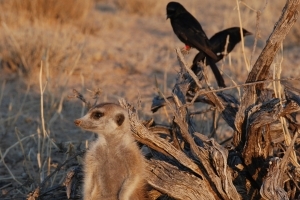Drongo mimics alarm calls to steal food from other species, finds UCT biologist
02 May 2014 | Story by Newsroom
The drongo, an African bird, deceives other species, including meerkats, by mimicking their alarm calls in order to scare them away and steal their abandoned food, according to a new study published in the 2 May 2014 edition of the journal Science. However, just as in Aesop's fable about the boy who cried wolf, the drongo can make too many false alarms and cause members of the exploited species to wise up. But when one false alarm call stops working, drongos mimic a different alarm call, keeping up the deception racket and their access to stolen food.
Author Dr Tom Flower, a researcher in the Percy Fitzpatrick Institute of African Ornithology at the University of Cape Town, walked 5-15km a day, six days a week for six months every year since 2008, to observe and record drongo behaviour in the Kuruman River Reserve, which is part of the South African Kalahari desert, close to the Botswana border. Temperatures ranged from -11°C on cold winter mornings to 42°C in the summer sun. Dr Flower said: "I dread to think how many sand dunes I've climbed, but it was worth it to get the data I needed."
The Kuruman River Reserve is the home of a huge long-term study on meerkats that began in 1993 and was documented in the popular TV series Meerkat Manor. The meerkat project studies the behaviour of about 14 meerkat groups all of which are completely habituated to humans walking in and among them. Dr Flower said: "The project has been running for so long that the first thing a baby meerkat is likely to see when it emerges from its birth burrow, is a researcher waiting to watch its behaviour; as far as they're concerned we're part of their environment and little different from a tree. Few people realise that perhaps the world's most important field research project studying the evolution of cooperative societies is located in South Africa."
Other species in the area are also habituated to people watching them at distances of less than five metres, including the drongos and another important species from which they steal food, a bird called the pied babbler. Dr Flower said: "That means that I and other researchers can get right into the thick of the action. We can unravel the interactions between all these animals because different individuals are identifiable by coloured leg bands (in the case of the birds), or L'Oreal hair dye marks on the fur of the meerkats (don't worry, it's been tested on humans)."
In the course of his research on drongos, Dr Flower has habituated and colour-ringed about 200 birds living in 40 territories which overlap with those of the meerkats and babblers. He said: "I've trained the drongos to come to a call. So if I want to find drongo 'Dave', for example, I can walk into his territory, give a call and he'll come flying over to me in return for a mealworm reward. He'll rapidly get back to his natural behaviour, hawking flies or following meerkats and babblers to steal their food, allowing me to tag along and watch what happens."
Dr Flower describes pied babblers as "the bird equivalent of meerkats, with mum and dad doing all the breeding while their offspring stay at home to help raise their younger siblings". A co-author on the Drongo manuscript, Dr Amanda Ridley, began studying babblers on the reserve in 2003, observing as many as 14 groups of babblers that are completely tolerant of people walking with them and watching their behaviour.
Dr Flower worked on the Kuruman meerkat research project in 2003 and became the meerkat research and reserve manager from 2004 to 2007. He started work on the drongo project in 2008. He said: "This kind of access to so many different animals is unrivalled anywhere in the world and was key to the observations and experiments that underpinned my findings." Dr Flower is now following juvenile drongos during their development, to learn more about how they learn the mimicking behaviour.
Audio recordings of the drongo:
Glossy starling alarm call at a predator
Glossy starling mimic alarm call made by drongo in a food theft attempt
Meerkat bark alarm call at a predator
Meerkat bark mimic alarm call made by drongo in a food theft attempt
Media release issued by Pat Lucas, UCT Communication and Marketing Department. Email: pat.lucas@uct.ac.za
 This work is licensed under a Creative Commons Attribution-NoDerivatives 4.0 International License.
This work is licensed under a Creative Commons Attribution-NoDerivatives 4.0 International License.
Please view the republishing articles page for more information.










